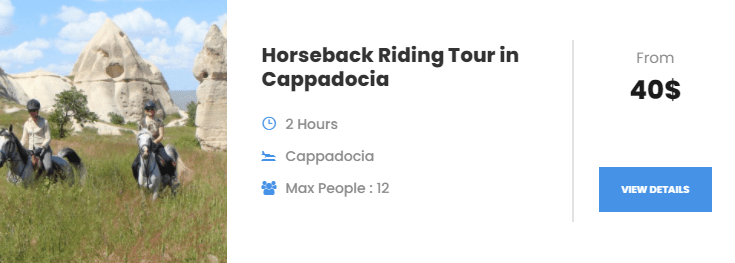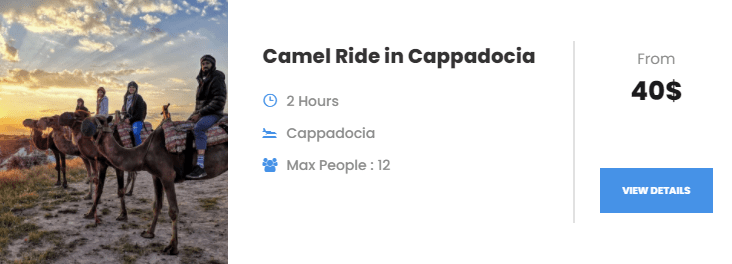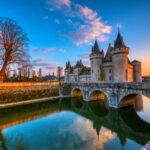Highlights Of Cappadocia
Introduction
Highlights Of Cappadocia – High on every tourist’s Turkey hit-list, Cappadocia is an enchanting region of swirling volcanic-rock landscapes that seem to have been fashioned by mischievous elves. Humans have settled in this area since the Bronze Age and have left their own mark on this weird and wacky moonscape by burrowing into the soft volcanic rock to live.
Explore the following map to see all indicated locations in this article.
[put_wpgm id=7]
The star sightseeing attractions are villages carved out of the hillsides; Byzantine era rock-cut churches with dazzling frescoes; and labyrinthine underground cities, where early Christians once hid from invaders. It’s a magical wonderland brimming with things to do that both nature lovers and history buffs can appreciate. For ideas on the best places to visit, see our list of the top attractions in Cappadocia.
Devrent – Imagination Valley
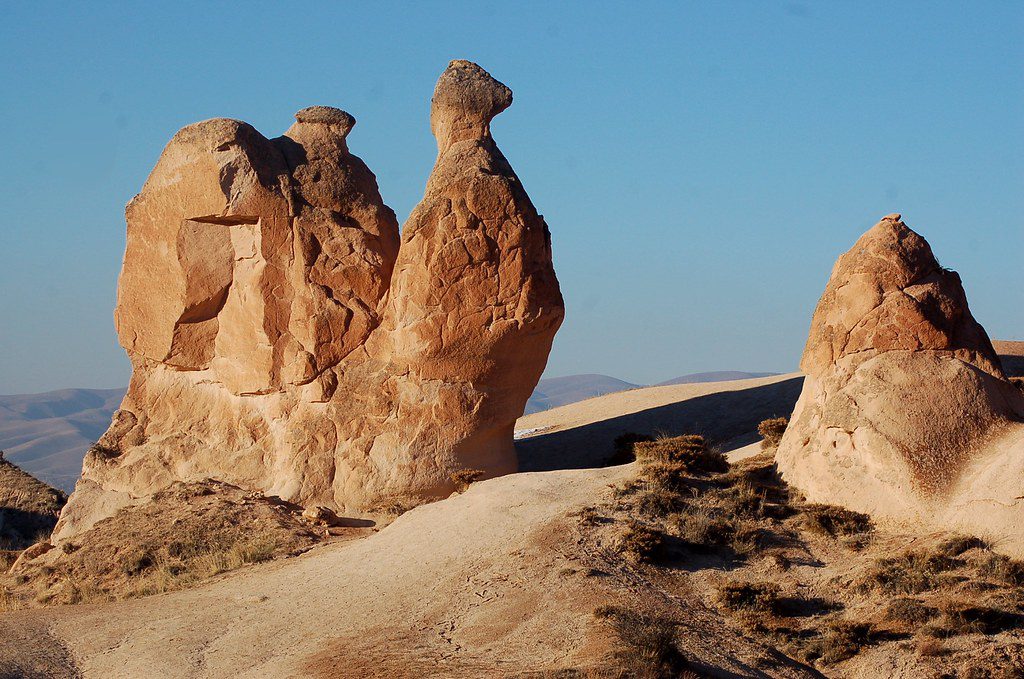
Devrent is located on the way from Urgup to Avanos town in Cappadocia. The road dividing the valley was used for centuries by the locals of Cappadocia. The valley gets narrower as you approach from the highlands of Urgup. Locals called it Devrent which means narrow pass in Persian. You can find many cities, towns or locations with the same name in Iran, Azerbaijan and Turkey. When you start driving to Avanos from Urgup, you will arrive to the top of the Devrent – Imagination Valley. Road curves to the right and takes you directly to Avanos. You need to follow brown Zelve sign to reach to the center of Devrent – Imagination Valley. After parking by the small souvenir shops in the bottom, you will immediately understand why travelers called it Imagination Valley. There are various types of fairy chimneys. It is because of volcanic nature of Cappadocia. Millions of years ago, three main volcanic mountains threw excessive amounts of volcanic tuff. Different ignimbrite layers of volcanic tuff were created in a very long time frame. It is easy to distinguish these layers because of their different colors. Besides the volcanic tuff, sedimentary rock layers were covering the ignimbrites.

The volcanic rocks and sedimentary rocks are lying on top each other like the layers of a cake. When the rain and the wind started to erode these layers, all reacted differently to the natural forces because the density of the minerals inside the volcanic rocks and sedimentary rocks are different from each other. In the case of Devrent –Imagination valley, thick iron rich ignimbrite layer contains pieces of basalt in different sizes. The basalt inside the ignimbrites are called volcanic bombs in geology. You can remember these huge pieces of fire balls from any Hollywood movie with erupting volcanic mountains. Volcanic mountains were like children throwing stones in to the mud. Basalt or harder types of rocks were sinking into the ignimbrite layers and cooling down while the volcanic mountain created more and more tuff to bury those volcanic bombs. When the rain and wind erosion started, basalt or other type of harder rocks resisted to these natural forces while softer ignimbrites washed away quicker. The basalt pieces were spread randomly into the volcanic tuff and they created different shapes of monoliths looking like animals, hats and cartoon characters. When the first travelers of Cappadocia came to Devrent Valley, they immediately realized some fairy chimneys looked like a camel, seal, hat of Napoleon Bonaparte and many different figures. They gave the famous well deserved imagination title than.
Pasabag – Monks Valley
Pasabag is called Monks Valley in many guide books. The first tourists of Cappadocia were exploring the caves carved into the huge fairy chimneys of Pasabag and heard from the locals that they were small monasteries. Since the monasteries have monks, the area was called Monks Valley by the first explorers of the region. Locals call the area as Pasabag. Pasa stands for Pasha in Turkish and bag means vineyard. Some of the farmers who maintained the vineyards of the area were veterans of the Independence War of Republic of Turkey. Pasha is the highest rank in the Ottoman Army. Today, Turkish people still call their veterans pasha to honor them and appreciate their efforts in the battles. As a result of those farmers, locals called the area Pasabag. It is located in the middle of the popular Cappadocia attractions. One can easily reach there by driving from Urgup, Avanos or Goreme since it is located in the middle of these three towns. Besides, a nice walk in the Red and Rose Valley can be extended all the way to Pasabag after Cavusin Village which is the end of these popular trails.

Monks Valley is famous for the beautiful fairy chimneys. It is also the most convenient place to comprehend the formation of these wonders of the world. The width of the area is very advantageous to take panoramic pictures of fairy chimneys. You can use them to explain the evolution of fairy chimneys to your curious friends. When you climb to a higher place right after entering the museum in Pasabag, you can observe the whole area. While fairy chimneys next to the mountain is wider and closer to each other, fairy chimneys further are higher, thinner and further from each other. That is because the whole area was looking like the yellow hills behind the museum. Because running water and rain erosion was washing away the softer volcanic rocks while stronger rocks were resisting to them. As a result of millions of years of erosion, fairy chimneys of Cappadocia were created and the process is still going on. While older fairy chimneys cannot resist to the natural forces and disappear at a very slow pace, younger fairy chimneys are slowly growing up in the very same place. This is the inevitable destiny of Cappadocia.
Pigeon Valley – Güvercinlik
Pigeon Valley is stretching from Goreme Village to the outskirts of Uchisar. When you climb to the castle of Uchisar town, you can see the beginning and the end ofthe valley. Almost all tours in Cappadocia stop by beautiful panoramas. The most popular of them are the Pigeon Valley stop by Uchisar and panorama of Goreme village which is locally known as Esentepe. Both locations have impressive views with the Pigeon Valley lying in front of you, Erciyes Volcanic Mountain in the horizon and pigeon houses built on the slopes of the valley. When you are approaching to Uchisar town, you can easily notice the touristy crowd on the right side of the road. They are taking pictures of the first half of the pigeon valley and the old town of Uchisar town. The pigeon houses in that panorama are closer as the valley is narrower in the beginning. The other view point of the Pigeon Valley is the Esentepe area located on the way to Goreme from Uchisar town. There are many panorama cafes on the right side of the road. The view you get is totally different than the other side of the Pigeon Valley. It is because of the different type of volcanic ignimbrites on this side of the valley. The valley is wider in this area and there are more fairy chimneys to see unlike the first part of the pigeon valley.

There are two paths in the Pigeon Valley. Due to the deep water erosion of the sedimentary rocks in the middle of the valley, it is not possible to continue all the way down to Goreme after starting from Uchisar Town. That enhances your walking experience as you will walk through the old town of Uchisar town to get back into the track. The old and new stone mansions of Uchisar will give you broad information about how the locals used to live in the old town and how investors are flooding money to tourism industry and recreating the paysage of the town. After starting from the Pigeon Valley viewpoint, you will arrive to the outskirts of old Uchisar Town. Argos Hotel’s vineyards will appear on your left and the dirt track will take you up to the old town. You will have to find your way in through the boutique hotels of Uchisar town and walk by a few luxurious hotels. Don’t forget to enjoy the view on your right side as you enjoy the architecture of Uchisar town. The cobbled stone road will meet with the main road from Uchisar tow Goreme.
Before that intersection, you will notice a fairy chimney on the right side with and art piece across the house. The wooden pillars have terra cotta pigeons with various colors on top of them. It is a nice way of marking the entrance of the Pigeon Valley. When you walk in between the fairy chimney and the artistic pigeons, you will enter the second part of the Pigeon Valley. After one and half hours of walk, you will arrive to Goreme Village. A walk through Goreme is also recommended for more views of the volcanic Cappadocia landscape.
Uchisar
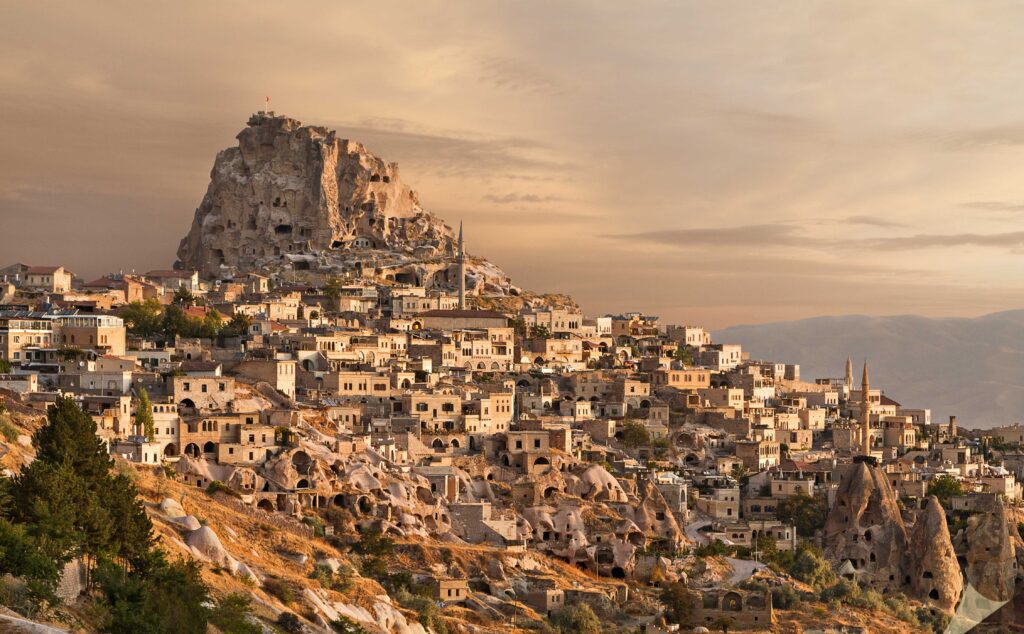
Uchisar castle is marking the center of the Uchisar town. Cappadocia’s famous volcanic landscape is a triangle. Uchisar marks the western corner of this triangle along with Avanos in the north and Urgup in the east. While Uchisar town is just thirty minutes away from Nevsehir Kapadokya Airport, it is only one hour away from Kayseri Erkilet Airport. Uchisar Castle is dividing the new and the old towns of Uchisar. Modern Uchisar sits in the South West of the castle while the old Uchisar town encircles the castle from South to North. Old town is established on the Eastern façade of the castle and has phenomenal views of Cappadocia. The view you get from the castle top is breathtaking. It is highly recommended to climb on the top of Uchisar Castle to comprehend the size of volcanic Cappadocia.
Ortahisar
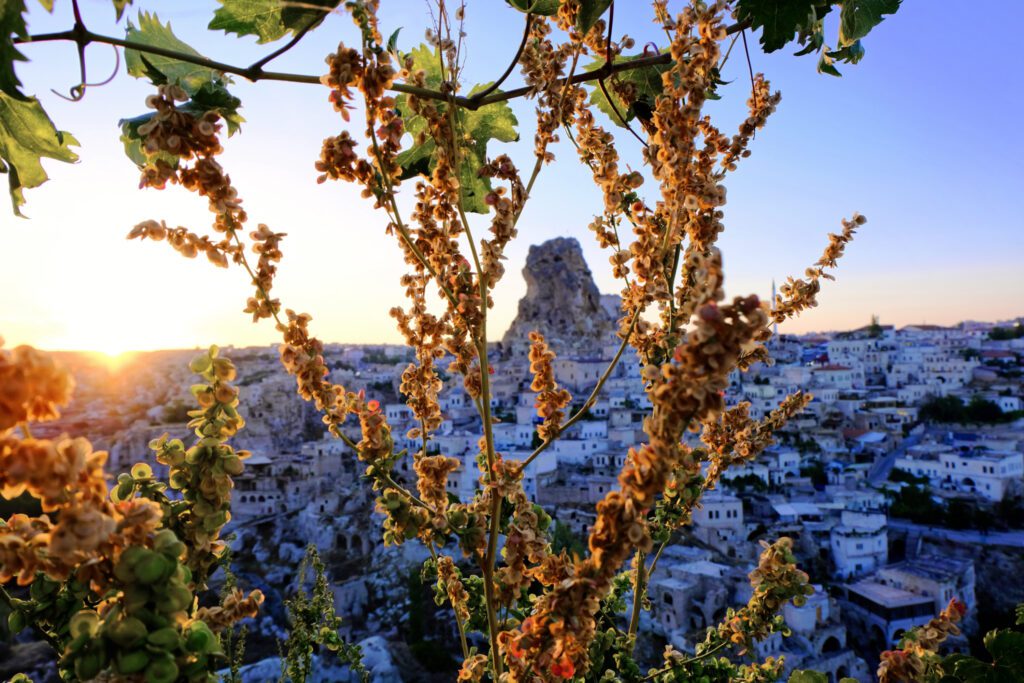
Ortahisar town is located seven kilometers away from Urgup. When you are driving around Cappadocia, you will definitely drive by Ortahisar town a few times since it is located on the road from Urgup to Uchisar and Goreme. While one of the intersections of Ortahisar take you to the world famous Goreme Open Air Museum, the other one takes you to the top of the Red and Rose Valleys. The panorama of the Red Valley is the best place to watch the sunset in Cappadocia with a glass of local wine. Locally called Kizilvadi, Red Valley is the starting point of the beautiful Red and Rose Valley walks. After a three minute drive from the main road, Ortahisar old town is full of surprises to any type of traveler. Small souvenir shops and cafes are surrounding the skirts of the Ortahisar Castle which is the second peak of Cappadocia. The view points across the old town has an impressive scenery of the town and two valleys encircling the castle of Ortahisar. There is a cute little Ethnographical Museum in the center of Ortahisar town. Legendary poet and collector Crazy Ali’s shop is on the other side of the parking area near the museum.
Love Valley
Love Valley is located on the left hand side of the road from Goreme to Cavusin village. Before Cavusin town, there is an intersection to Nevsehir city which is the province of Cappadocia. When you turn left to Nevsehir direction and drive roughly one and half kilometers, you will see the graffiti of Love Valley on an old stone hut. The dirt track will take you to the top of the Love Valley. You can easily notice the parking area on the right hand side after driving less than a kilometer. The popular view point of Love Valley has breathtaking views of the end of the Love Valley. This part is the most impressive part of the Love Valley thanks to the tallest monoliths of Cappadocia. They are responsible for the famous name of the Love Valley.

Love Valley stretches around three kilometers on the right hand side of Goreme. When you are driving from Uchisar to Goreme, you easily notice the view of the Pigeon Valley on the right. Love Valley is on the other side of the road but not visible from the vehicles. The hiking trail inside the valley is beautiful. You will see an intersection in the end of Uchisar as you drive to Goreme. There is a jewelry shop on the left. The dirt track in the end of the shop which will take you to the entrance of the Love Valley. You will easily notice the Baglidere sign on the right after a few minutes walking. Your hike will last around two hours until you see the most beautiful fairy chimneys of Cappadocia.
They are totally different from the fairy chimneys you have seen in Devrent– Imagination Valley, Pasabag –Monks Valley or Zelve Open Air Museum. They are the tallest fairy chimneys within the National Park of Goreme which is Cappadocia. It feels amazing to approach to a natural gigantic formation which is millions of years old. When you look closer to the bodies of the fairy chimneys, you easily notice the round stones and silt which is different from volcanic tuff. The majority of the tall bodies of the fairy chimneys in Love Valley are sedimentary rocks. This is unique characteristics of the Love Valley fairy chimneys.
Zelve Open Air Museum
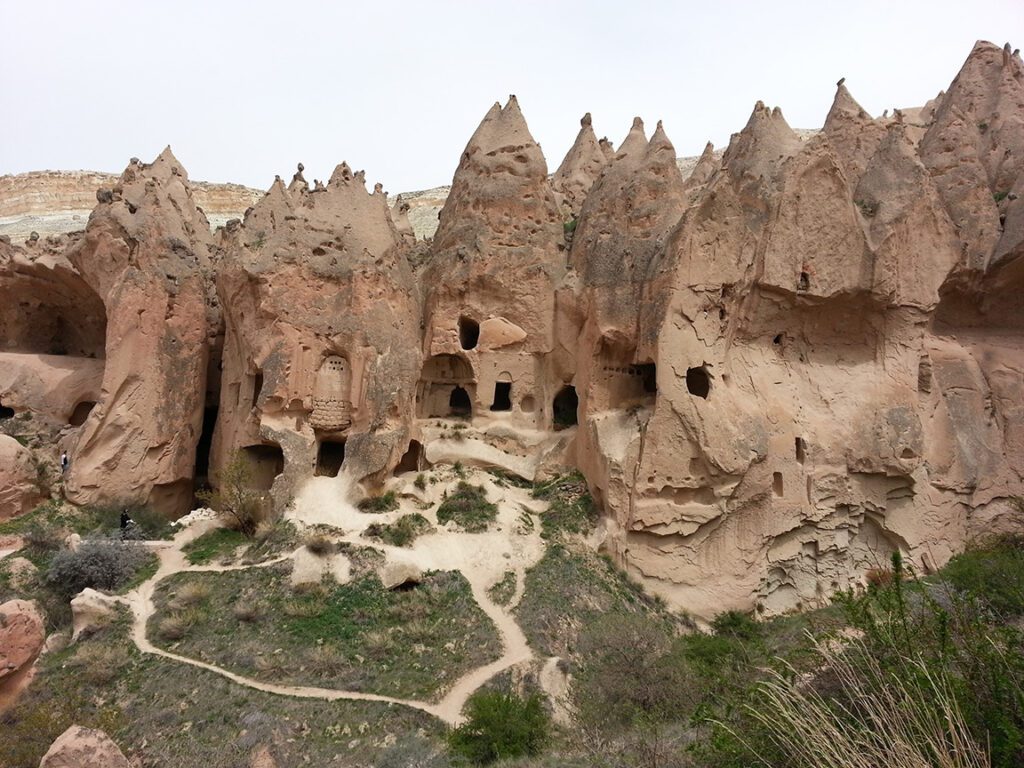
Zelve Open Air Museum is located only one mile away from Pasabag – Monks Valley. Among with Pasabag – Monks Valley, Zelve is also in the middle of three popular settlements of Cappadocia such as Avanos, Urgup and Goreme. While it is accessible with a nice panoramic walk from Goreme, there are also mutual shuttle busses stopping by Zelve from Avanos and Urgup. There is more information in our Pasabag – Monks Valley blog about how to get to Zelve and Pasabag – Monks Valley area. Cappadocia was created by volcanic activities. Three main and many small volcanic chimneys erupted in the region. They sprayed enormous amounts of different volcanic rocks. On the way to Zelve Open Air Museum, you can see the three main volcanic ignimbrite layers of Cappadocia. They are distinguished form each other thanks to the natural colors of the rocks. Minerals inside the volcanic tuff dioxide because of water and oxygen in the air and give the color we see today. The volcanic tuff of Pasabag – Monks Valley is rich in sulfur and chalk. As a result, yellow and white are the dominant colors of Pasabag – Monks Valley. The ignimbrites of Zelve Open Air Museum are containing iron minerals which give the red color to the three valleys of the Open Air Museum. Another difference of Zelve from many other attractions of Cappadocia is the number of troglodyte houses found in the museum.
The dovecotes carved on top of the hills are impressive. While approaching to Zelve Open Air Museum, one don’t expect to see such a huge settlement behind the trees and cafes around the entrance of the museum. Thirty steps after the ticket office, you will be amazed to see the huge size of Zelve settlement. There are three valleys extending into the volcanic hills to East. The valleys are embroidered with hand carved caves. The hill tops are full of pigeon houses. Zelve Open Air Museum is very rich in history and culture. While walking in the open air museum, you are encountering a mill stone, church, mosque, barn, winery, pigeon housesand a common bath. Zelve has everything a medieval Cappadocian village had. That is also the main difference of Zelve from Pasabag – Monks Valley.
Underground Cities
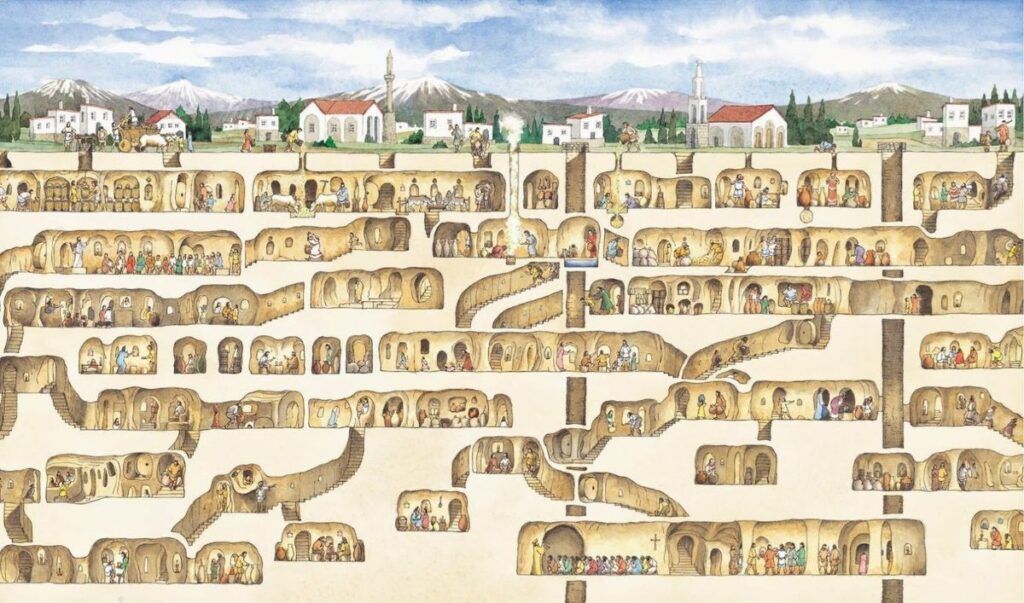
You can read our earlier blog about Cappadocia Underground Cities . Briefly, underground cities were complex cave systems built by almost all communities once lived in Cappadocia for storage, winery, shelter and barn uses. I would like to mention that no one lived in the underground permanently. Life was going on on the surface. People of Cappadocia relied on agriculture and livestock since the beginning of history. As a result, they spent most of their time outdoors dealing with soil and animals. Underground cities were their cultural centers. They stored their food in the underground. They kept their animals secure during bad weather. They protected themselves from enemies. In case of emergency an underground city was there to keep the people, animals and their produce safe.
Goreme Open Air Museum
All the churches in Goreme Open Air Museum are very well preserved as the Christians of Cappadocia used them until 1923. After the population exchange held between Greeks and the Republic of Turkey, churches were abandoned until the 1960s when converted to a museum. Since 1985, Cappadocia and Cave Churches are listed on UNESCO and protected by the Republic of Turkey’s Tourism and Culture Ministry. Click here to visit Goreme Open Air Museum virtually

The best frescoed churches of Goreme Open Air Museum;
- The Dark Church
- The Buckle Church
- The Apple Church
- Church of Sandals
**Churches with seccos**
- Chapel of Saint Basil
- Snake Church
- Church with the X
- Church of Catherine
- Church of Barbara
Soganli Valley

One hour drive will take you to Soganli Valley after you leave Kayseri airport. There is a small fee to enter the valley where you can drive in with your car. I recommend you to park your car to the village square and meet with the ladies of Soganli making rag dolls and racing each other for some business with you. You can start walking through the abandoned houses of the old Soganli village. The route meandering up the old village takes you to the Hidden Church and Church with the dome. The churches are all carved into the volcanic ignimbrite layers but Church with the dome is carved from the outside to give an outstanding appeareance visible throughout the valley. The path will finish in a nice little restaurant managed by a local family. They serve limited but delicious food in the end of the valley. Snake church is just a few steps from this cute little restaurant where you can see beautiful late Byzantium frescoes. The asphalt road in front of Snake Church complex will take you to Karabas Church to see another intact monastic settlement. Your car is now five minutes walk away in the middle of the old Soganli Square. Don’t miss to picture the numerous pigeon houses embellishing the slopes of the Soganli Village.
Mustafapasa (Sinasos)
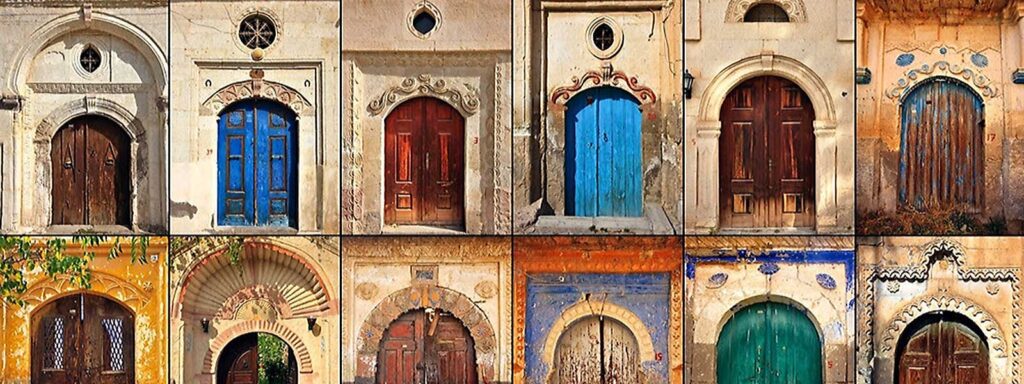
Mustafapasa is only five kilometers away from Urgup. Popular Cappadocia attractions are in the center of a triangle whose corners are Uchisar, Avanos and Urgup. Urgup is the biggest city of Nevsehir province and more popular among the domestic tourists because of the famous TV shows. One can easily come across a production company shooting a movie, advertisement, soup opera or a documentary in Cappadocia. As Urgup town is bigger than other cities of Cappadocia, many production companies use it as headquarters. It is in the middle of the two airports of Cappadocia. Urgup is only ten minutes away from Mustafapasa which has beautiful architecture more than enough to impress the people in front of their televisions. Cappadocia settlements were very cosmopolitan until the end of the First World War.
During the fall of the Ottomans after the war, a new parliament was established in Ankara. The independence campaign lasted four years and Republic of Turkey was officially recognized by the rest of the world in 1923. In January 1923, Greeks and Turks made an agreement to swap the people living in their countries. More than one and half million people were exchanged in between Turkey and Greece. Turks were approximately thirty percent of this exchange while the Greeks were the majority. After the exchange, settlements with Greek names were changed to Turkish language. However, nobody is surprised when you ask directions for Sinassos as it is still a common name among the locals of Cappadocia. Most of the Greeks living in Mustafapasa were located to Euboea island of Greece. If you google ‘Prokopi Euboea’ you will find the new Prokopi town Greeks from Sinassos established in Euboea island. The highlight of the Prokopi Town is the Church of Saint John the Russian who has lived and died in Urgup Cappadocia, Turkey. His grave was taken to Greece during the population exchange.
Ihlara Valley
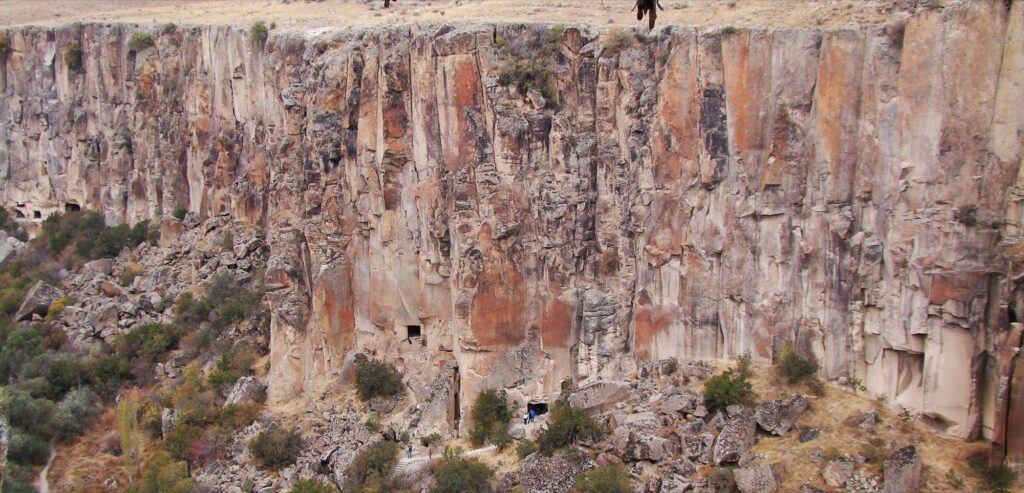
Ihlara valley is a gorge created by Peristrema stream coming from Melendiz Volcanic Mountain. The stream slowly carved the soft volcanic tufa rocks of the area and created the Ihlara Valley in millions of years. The Valley itself is like an oasis in the middle of nowhere within the vicinity of Aksaray province. The micro climate inside the valley protects the vegetation from winter frost and Peristrema stream continues to flow througout the year. It is also one of the two sweet water sources of the other popular attraction of Cappadocia visitors; The Salt Lake. The valley is 14 kilometers long and depth changes from 50 to 70 meters. Width is in between 70 to 150 meters due to the 26 meanders Peristrema creates in the valley. This however, gave a great protection to the Christians hiding from their enemies. They carved their churches, dwellings, stalls, wineries, storages and graves into the volcanic rocks in between 3rd to 13th Centuries. During that time frame, hundreds of cave structures were created by Christian communities which are still visited by the tourists. Today, one can easily visit more than 10 churches during a full walk inside the valley.
Red and Rose Valleys

Cappadocia’s most beautiful intertwining valleys lie between the villages of Göreme and Çavusin. Here, the rolling and rippling rock faces arc out across the countryside in a palette of pastel pink, yellow, and orange cliffs, formed by volcanic explosion and millennia of wind and water erosion. Between the cliffs are lush orchards and vegetable plots still tended by local farmers, while carved into the rock are hidden churches and hermit-hideouts, which date back to the Byzantine era. There are dozens of hiking trails, so it’s the perfect opportunity to grab your walking shoes and head out onto the paths. Three particular attractions within Rose Valley are the Kolonlu Kilise (Columned Church); Haçli Kilise (Church of the Cross), with its mammoth cross carved into the cave ceiling; and the Uç Haçli Kilise (Church of the Three Crosses), with its amazingly preserved ceiling carvings and interesting (though severely damaged) frescoes
Çavusin
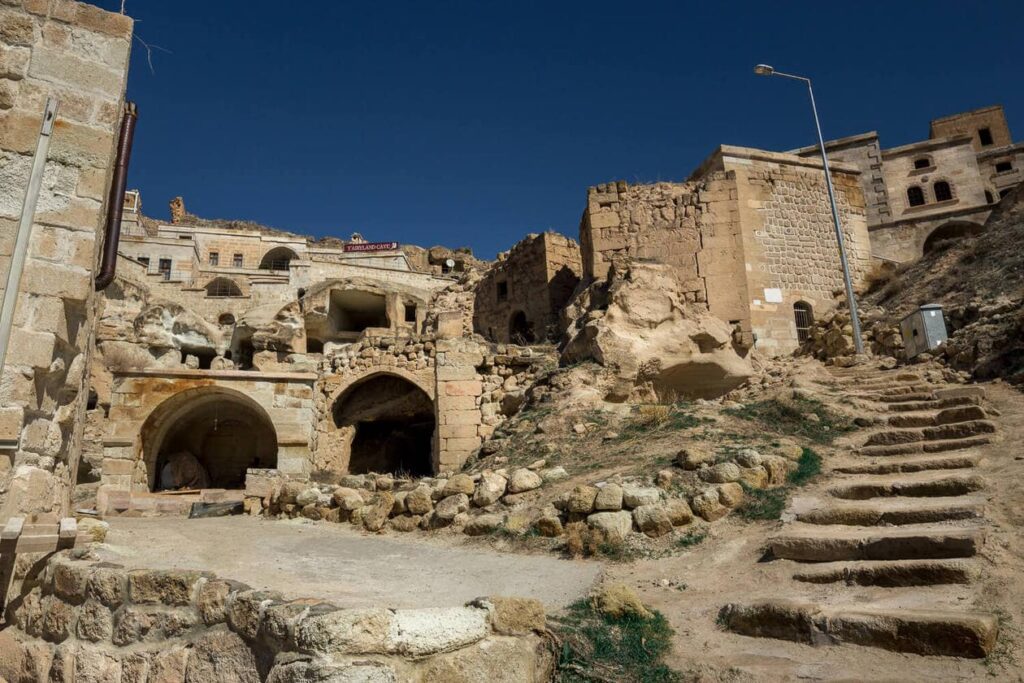
The main attractions in the dinky village of Çavusin are two lovely Byzantine churches. By the entrance into town is the Çavusin Church (also known as the Big Pigeon House Church, due to having been used as a local pigeon house in the early 20th century) with a stunning interior of frescoes. In the old village center, after hiking high up on the ridge above the tumble of derelict houses, is the Church of St. John the Baptist. This is thought to be the oldest church in Cappadocia, and its basilica-like proportions and fat columns are an impressive sight
Avanos
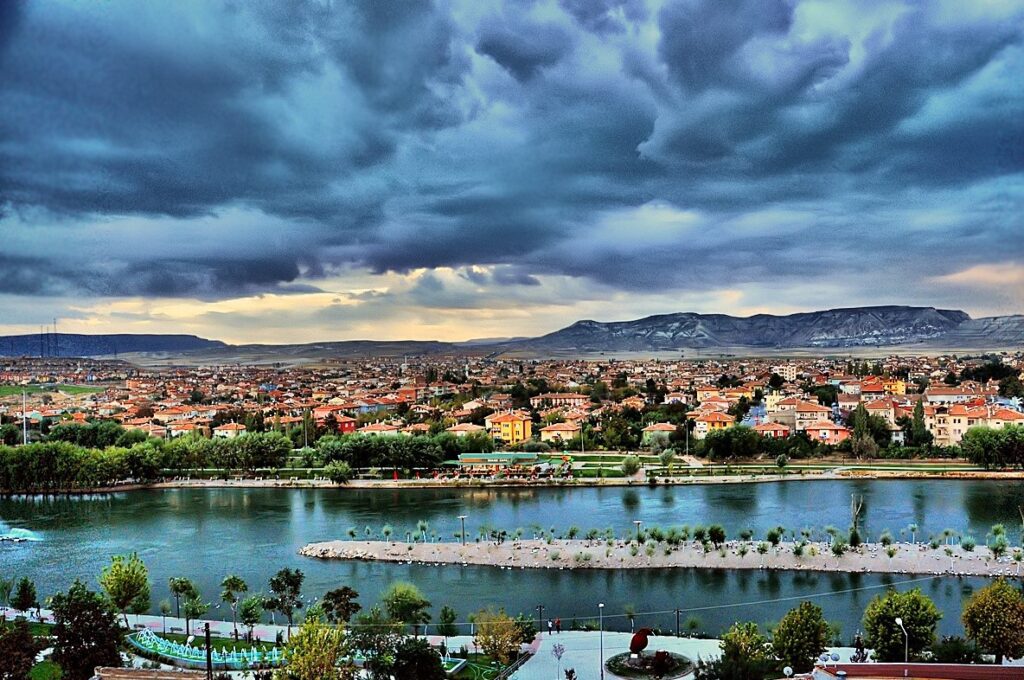
Avanos is a bustling provincial town beside the Kizilirmak River. The older part of the town winds up the hillside in a maze of cobblestone roads lined by dilapidated Ottoman mansions. Avanos’ main attraction is its pottery. This town has a pottery industry history that stretches back to the Hittite period and now, like then, local artisans utilize the distinctive red clay of the Kizilirmak River for their craft. Potter workshops and shops are along the main road in the town center, beside the river, and many of their owners are happy to let you watch them work or have a go at creating a simple pot yourself.
Eski Gümüsler Monastery

Barely 10 kilometers northeast of the town of Nigde in Cappadocia’s far south is the Eski Gümüsler Monastery. This rock church has some very impressive frescoes that rival those of the more famous churches near Göreme. The paintings date from the 11th century and include the Annunciation and the Virgin Mary with baby Jesus flanked by the Archangels Gabriel and Michael. Just as interesting as the frescoes is the mazy series of tunnels you can explore within the complex that have been recently restored and opened up for tourism. They are a bit of a squeeze in parts but great fun to scramble through.
Related Reading for Cappadocia
Cappadocia Underground Cities , Cappadocia Balloon Tours, Cappadocia City Breaks , Best Cave Hotels in Cappadocia


